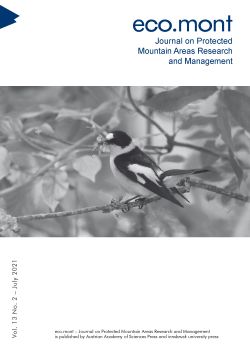Valerie Braun – Martin Coy – Günter Köck (Eds.)
eco.mont
Journal on Protected Mountain Areas Research and Management
Hui Wang,
Dong Xie,
Wen Xiong,
Wei Tang,
Zhigang Wu,
Keyan Xiao,
Qiang Wang
S. 58 - 61
doi:
10.1553/eco.mont-13-2s58
Verlag der Österreichischen Akademie der Wissenschaften
doi:
10.1553/eco.mont-13-2s58
Abstract:
Lhalu wetland, located in the northwest of Lhasa city, Tibet, is the highest and largest urban natural wetland in the world. Due to its specific climate and the unique plateau ecosystem, it is a hotspot of endemic and endangered species. Lhalu wetland is an important wetland for Lhasa city for its biodiversity and for enhancing human well-being. However, due to global warming, over-exploitation and the presence of non-native species, it has suffered serious ecosystem damage and biodiversity loss. To protect biodiversity and the functioning of the ecosystem, new measures are needed, and current measures should be better enforced. This study is important for biodiversity conservation and the management of Lhalu wetland in the Qinghai- Tibet plateau.
urban wetland, biodiversity conservation, human settlement, ecological restoration
Published Online:
2021/06/30 08:08:38
Object Identifier:
0xc1aa5576 0x003c9da8
Rights:https://creativecommons.org/licenses/by-nc-nd/4.0/
The journal “eco.mont” – Journal of protected mountain areas research and management – was published for the first time in June 2009.
The journal was founded as a joint initiative of the Alpine Network of Protected Areas (ALPARC), the International Scientific Committee on Research in the Alps (ISCAR), the Austrian Academy of Sciences (ÖAW) and the University of Innsbruck.
The journal aims to highlight research on and management issues in protected areas in the Alps without excluding other protected mountain areas in Europe or overseas. Its target audiences are scientists from all related disciplines, managers of protected areas and interested individuals including practitioners, visitors, teachers, etc.
The journal presents peer-reviewed articles in English by authors who research protected mountain areas and management issues within these areas. It's published twice a year as a collaboration of the Austrian Academy of Sciences Press – responsible for the e-version – and Innsbruck University Press – responsible for the print version.
Die Zeitschrift „eco.mont“ – Zeitschrift zur Forschung in Gebirgsschutzgebieten – erschien im Juni 2009 zum ersten Mal. Die Zeitschrift wurde auf Initiative des Netzwerks Alpiner Schutzgebiete (ALPARC), der Schweizer Akademie der Naturwissenschaften (ISCAR), der Österreichischen Akademie der Wissenschaften (ÖAW) und der Universität Innsbruck gegründet. Sie hat das Ziel, Themen zu behandeln, die gleichzeitig Forschung und Verwaltung in und über die Schutzgebiete der Alpen betreffen, ohne dabei andere Gebirgsschutzgebiete Europas oder anderswo auszuschließen. Diese neue Zeitschrift richtet sich an ein Publikum von Wissenschaftlern der verschiedensten Fachbereiche, an die Verwalter von Schutzgebieten und an alle sonstigen Interessierten, Praktiker, Besucher, Lehrpersonal etc. einbegriffen. Die Zeitschrift veröffentlicht begutachtete Beiträge auf Englisch von Autoren, die Fragen der Gebirgsschutzgebiete und deren Verwaltung betreffen. Sie erscheint zweimal pro Jahr, auf der Basis der gemeinsamen Anstrengungen des Verlags der Österreichischen Akademie der Wissenschaften, der für die digitale Fassung verantwortlich ist, und der Presse der Universität Innsbruck, verantwortlich für die gedruckte Fassung.



 Home
Home Print
Print
 References
References
 Share
Share

